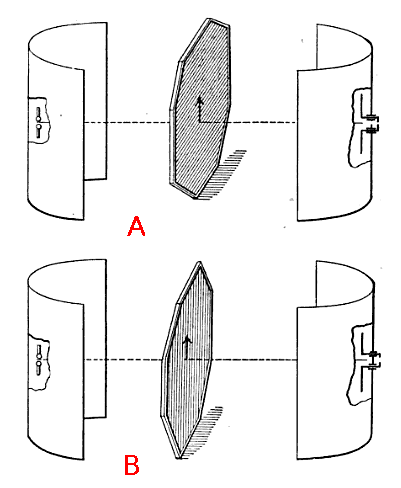Image: Hertz radio wave experiments - polarization filter
Description: Diagram of experiment performed by Heinrich Hertz in 1888 demonstrating polarization of radio waves. At left is Hertz's spark-gap transmitter consisting of a dipole antenna of two brass bars with a spark gap between them, powered by high voltage from a Ruhmkorff coil (not shown) attached to the dipole, which is mounted along the focal line of a cylindrical parabolic reflector made of a piece of sheet metal. High voltage from the coil causes sparks to jump between the halves of the dipole, creating high frequency oscillating currents in the dipole which radiate a pulse of radio waves. At right is Hertz's receiver, consisting of a similar dipole and parabolic reflector attached to a micrometer spark gap. Between them is a polarization filter consisting of a grating of parallel 1 mm wires 3 cm apart on an octagonal wood frame The transmitter generated 66 cm radio waves in the UHF band at about 450 MHz. When the polarization filter is removed, the receiver receives the radio waves produced by the transmitter, producing sparks at the spark gap. When the filter is inserted with its wires horizontal (A, top), the radio waves are uninterrupted. However when the filter is rotated the sparks become more feeble, until when the wires are vertical (B, bottom) no radio waves get through. This is because the radio waves emitted by the transmitter's vertical dipole are vertically polarized, with its electric field oriented vertically. The wires of the filter only conduct electric currents along their length, so they can only reflect the component of the electric field parallel to their length. This is similar to the way an optical polarizing filter works
Title: Hertz radio wave experiments - polarization filter
Credit: Retrieved December 17, 2015 from George Washington Pierce (1910) Principles of Wireless Telegraphy, McGraw-Hill Book Co., New York, p. 54, fig. 32 on Google Books
Author: George Washington Pierce
Usage Terms: Public domain
License: Public domain
Attribution Required?: No
Image usage
The following page links to this image:


